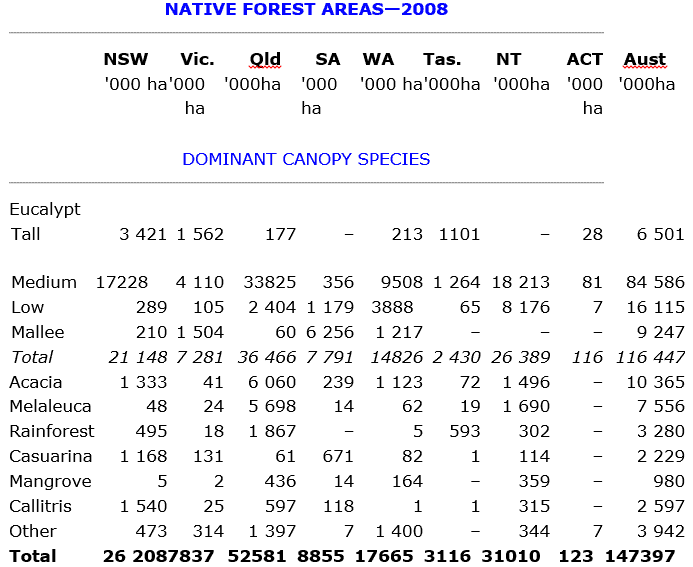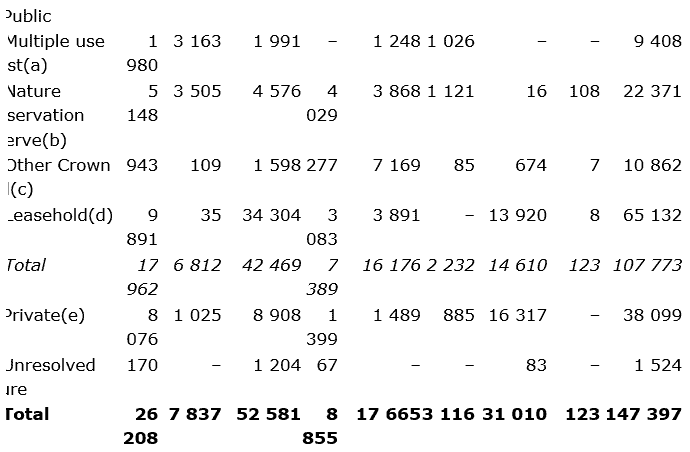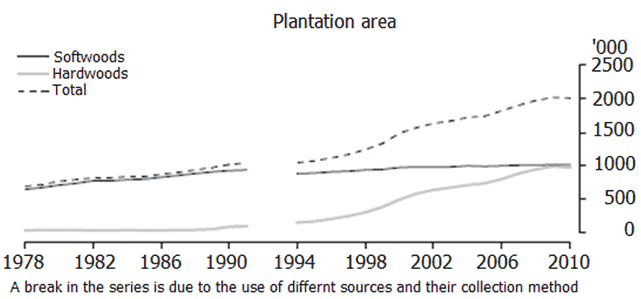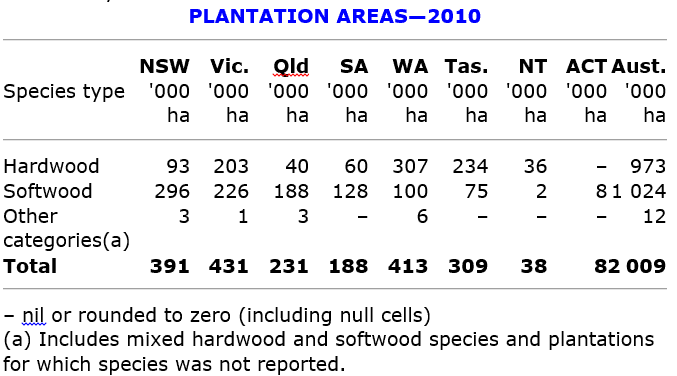The word “Forestry” is as divisive as the “National Party is to Greens and Greens is to the National Party.” The last thing I want my great grandchildren to see is “A town in an oasis of prosperity in a desert of poverty where nothing grows.”
Forests is one of the most important biosphere regions on earth. They protect our soils and water resources, provide habitat for organisms, absorb large quantities of carbon dioxide from the atmosphere, and are used for cultural, recreational, educational and spiritual purposes.
Australia’s unique forests, like the Amazon The Pine forests of the Northern hemisphere or the great kelp forests of the Great Australian Bite provide a sustainable resource base for the forestry sector. In Australia all Australians benefit through profits, jobs and environmental corridors where native hardwood trees are grown. Sustainable management of forests should integrate with the environment, commerce and community values.
The state and Territory governments are primarily responsible for forest management and developing forest policy. Unfortunately revenue comes ahead of Health.
Australia’s native and plantation forests are an important natural resource as they provide much of the timber and paper products consumed by Australians and support other products and services, such as honey, wildflowers, natural oils, firewood and craft wood.
The following facts and figures have been obtained from the Australian Bureau of Agricultural and Resource Economics and Sciences and the Australian Year Book.
The forestry and fishing industry in 2009–10 was valued at $3,567 million gross value added, which was 0.7mm of Australia’s gross domestic product.
In 2009–10, the Forestry and logging industry generated $3,567 million in sales and service income a 12mm increase on the previous year.
Industry value added (IVA) increased to $1,189 million in 2009–10, a 26mm rise over the previous year. Despite the increased IVA, fewer than half of the businesses in the industry made a profit or broke even.
| FORESTRY AND LOGGING INDUSTRY(a), Selected indicators | ||||||||||||
| Wages and salaries(b) | Total income | Sales and service income(c) | Operating profit before tax | Capital expenditure(d) | Industry value added | Profit margin | Made a profit | Broke even | Made a loss | |||
| ANZSIC Subdivision | $m | $m | $m | $m | $m | $m | mm | mm | mm | mm | ||
| Forestry and logging | ||||||||||||
| 2008–09 | 568 | 3 658 | 3 189 | *152 | ^779 | 940 | 4.8 | 28.5 | 3.2 | 68.4 | ||
| 2009–10 | 540 | 3 552 | 3 567 | –22 | *628 | 1 189 | –0.6 | 39.7 | 1.4 | 58.9 | ||
As can be seen total losses outweighed total profits. Wouldn’t the money be better spent promoting forests and their real value rather than decimating them?
This partnership approach between governments and the industry is reflected through major national policy initiatives such as the 1992 National Forest Policy Statement and the Plantations for Australia known as the 2020 Vision. The Plantations 2020 Vision aims to promote the expansion of Australia’s plantation estate. More recently, the passage of legislation to outlaw the trade of illegally harvested timber involved extensive consultation with state and Territory governments and industry.
Following on from the NFPS, Australia has spent more than fifteen years developing, implementing and reviewing Regional Forest Agreements which aim to achieve a balance between conservation and production in native forests, and provide security for the industry.
With a strong policy framework in place, government and industry continue to address issues affecting the viability and sustainability of Australia’s forest industries. The industry contributes over $22 billion of economic turnover each year and employs over 66 000 people.
A forest is defined as an area incorporating all living and nonliving components, dominated by trees having usually a single stem and a mature or potentially mature stand height exceeding two metres, and with an existing or potential crown cover of over-storey strata about equal to or greater than 20mm. This definition includes Australia’s diverse native forests, regardless of age. It is also sufficiently broad to encompass areas of trees that are sometimes described as woodlands.
Based on this definition, the total area of native forest is estimated at 147.4 million hectares, which is about 19mm of Australia’s land area. An estimated 107.8 million hectares (73mm) of native forest area is on public land and 38.1 million hectares (26mm) is on private land. Forests growing on public land consist of 65.1 million hectares (60mm) on leasehold tenure, 22.4 million hectares (21mm) in nature conservation reserves, 10.9 million hectares (10mm) on other Crown land, and 9.4 million hectares (9mm) managed by state forest authorities for multiple uses including wood production, recreation and informal reserves. Including forested leasehold land and private freehold forest, about 103.2 million hectares, or 70mm of Australia’s native forests, are privately managed.
Most of Australia’s forests are dominated by eucalypts, which include trees in the genera Eucalyptus, Corymbia and Angophora The second most extensive forest type are Acacia specie. Despite the predominance of these genera, Australia’s forests are very diverse, with more than 700 species of eucalypts, almost 1,000 Acacia species, and many other genera of forest trees. As a result, forests vary widely in their species composition, structure and in the fauna they support.


The plantation estate is dominated by a few species: about three quarters of softwood plantations by area is the imported radiata pine (Pinus radiata). Over half of the hardwood plantations by area is the Tasmanian blue gum (Eucalyptus globulus) and a further one quarter is shining gum (Eucalyptus nitens). These proportions are similar to those in previous years. A small increase is now seen in Eucalyptus grandis on the North coast of New South Wales.
Nearly all softwood plantations in Australia are managed primarily to produce saw logs to make sawn timber for building and construction. Pulpwood, produced from harvest thinning and low quality parts of the stems in stands managed primarily to produce saw logs, is used to make particleboard, medium density fiber board and paper products. Most hardwood plantations are managed to produce pulpwood for paper manufacturing. A small proportion are managed to produce saw logs, although most are too young to produce significant volumes when they are harvested.
For the first hundred years of plantation development in Australia, most of the investment was by governments. The proportion of plantations privately owned has been increasing steadily for many years but increased substantially in 2010 because government owned plantations in Queensland were sold to superannuation funds (graph 17.9). The proportion of plantations owned by managed investment scheme investors decreased substantially in 2010 as many were taken over by timber companies and other private investors and some have been written off following drought and recurring disease problems.

WOOD AND PAPER PRODUCTS
On average, each year, every Australian consumes the equivalent of about 1 cubic metre of harvested log in the form of timber products, including timber for home building, joinery, furniture and paper products. Those products are supplied from domestic production and imports.
Apart from sawn wood, other timber products include plywood, wood based paneling and reconstituted wood panels. Australian made wood based paneling include particleboard, medium density fiber board and hardboard. These are made from softwood or hardwood pulp logs, sawmill residues and harvest thinning.
A total of 25.1 million cubic metres of logs was harvested from Australian native forests and plantations in 2009–10. That volume was 1mm less than the previous year but 3mm more than ten years earlier. The volume harvested from native forests has almost halved (43mm or 4.8 million cubic metres) over ten years, while the volume harvested from plantations has increased five fold from 3.5 million cubic metres.
The total value of exports of forest products in 2009–10 was $2.3 billion. Woodchips comprised 38mm of that total and paper and paperboard products which were manufactured into primarily packaging and industrial paper, comprised of 29mm. The value of imports of forest products in 2009–10 was $4.2 billion, of which 52mm were paper and paperboard products which were primarily used for printing and writing paper. This indicates a trade deficit in forest products of $1.9 billion in 2009–10, down from the previous year’s level of $2.1 billion.
Pulp and paper mills use round wood thinning, low-quality logs, harvesting residues and sawmill waste, recycled paper and paperboard to produce a broad range of pulp and paper products. Over the past five years, the volume of pulpwood for paper and paperboard harvested from eucalypt plantations has increased by a third while the volume harvested from native forests has declined by 20mm.
Woodchips are extensively used to produce paper and paper products. The woodchip export industry uses sawmill residues and native forest logs that are unsuitable for sawmilling and are supplemented with logs harvested from native hardwoods. Sawmill waste material, that would otherwise be burnt, is also chipped for local pulpwood industries. Woodchips are also produced from thinning from softwood plantations and from hardwood plantations grown especially for the purpose.
The Australian Bureau of Agricultural and Resource Economics and Sciences (ABARES) reported that about 7.7 million cubic metres of logs were used for woodchip production for export in 2009 to 2010, a decrease of 18mm from five years ago. This was mainly due to a fall over the period of 2.5 million cubic metres (45mm) in production from native hardwood forests not being matched by the increase of only 1.5 million cubic metres from hardwood plantations. Production of woodchips for export from coniferous logs has declined from 1.3 million cubic metres to 0.6 million cubic metres over the last five years.

Deforestation of natural stands of forest are now no longer acceptable to the vast majority of the Australian population or tolerated by a majority of Australians. What is needed now is forward thinking strategists who can prioritize and targeted strategies for the short, mid and long term future in threatened species conservation and recovery. The focus of strategies should be on the well being of all living things with on ground actions that will support the balance, recovery of threatened species and research to provide the information needed for the most effective and robust management plans anywhere in the world. Those in control must ensure that the best biologist, botanists, ecologists, meteorologists and geologists are employed and deployed to ensure the best science and methods are conscripted to take the best advantage of monies available.
Research needs to be collated urgently from research previously carried coupled with new research data as it comes to hand to provide extensive habitat protection even within areas that are continually being harvested. The use of threatened, endangered and vulnerable flora and fauna species in the forests is a practical start for all species in the ecosystems involved. Information with strategies will assist foresters in managing and harvesting forest plantations with sensitive flora and fauna in mind limiting the impact on these organisms.
The use of shrubs including native legumes and native grasses will bring about a better balance without necessarily reducing timber volumes or times in harvesting mature logs, but can provide additional income and resources from native forest stands:
* A three tier forestry structure would enhance the forests for a wider variety of wildlife instead of the baron monocultures of the present time and thinking,
* A three tier forestry structure could utilize herbs for oils, fodder crops and even domestic organic fowls being raised beneath the canopies of plantations. The thought of growing wild herbal oils is new to Australia. Most the herbal, fragrant and medicinal oils are grown overseas as labour costs have been relatively high, the industry has been fractionalized and split over large non continuous districts making distillery both expensive and impractical. The opportunity to establish a large industry based on wild plant production and harvesting beneath plantation timbers makes the economics far more practical and serviceable. Due to the large differences in climatic, soil and soils it is not practical for me to expand here in any detail as every area, every location from near the coast, high in the mountains or semi arid areas all have something of value to contribute to a herbal oil industry. An oil industry could follow the initial years of hemp production.
* A three tier forestry structure would reduce the need for using natural forests for paper production and could easily be supplemented with the use of cannabis sativa. Hemp can produce 25 tonnes of dry pulp per hectare considering this and halving the quantity for inter planting rows with hardwood trees an additional 1,216,250 tonnes of fibre for paper could be produced annually over the first few years of growth in the new hardwood forests or up to 101,250,000 tonnes in the soft wood plantation forest. (Figures extrapolated from the one tenth of the total area under plantations in Australia under ideal growing conditions for Cannabis sativa and having two crop harvests a year.) This would increase the overall tonnage of fibre by around one and a half times what is being harvested at the present time.
* A three tier forestry structure would supplement the textile industry by growing crops for fibre like Cannabis sativa. The textile industry especially the cordage industry could benefit greatly from the introduction and growing of hemp for the textile industry where second grade fibres can be utilized very affectively.
* A three tier forestry structure would generate better incomes as a result of growing more than the single crop.
* A three tier forestry structure would assist in maintaining better soil structure and nutrient recycling,
* A three tier forestry structure would create additional employment in decentralized locations where unemployment is traditionally much higher.
* A three tier forestry structure would help eliminate many of the monoculture diseases the industry has faced over the past few years.
* A three tier forestry structure would be ideal for the growing of hard and difficult to obtain cabinet timbers that are now in high demand and have not been catered for.
* A three tier forestry structure would be very suitable for the production of various seed production presently not being grown commercially.
* A three tier forestry structure following some of the above crops and the layering of natural mulch would create the ideal microclimate for several species of native fungi. This would need further work but the cultivation of spore and setting of beneficial spores amongst plantation trees has a romantic appeal that could be extremely rewarding. I have seen several species growing beneath the canopies of plantation trees (Suillus luteus) yet nothing has been done to exploit these in the market place.
At least 8 different edible mushrooms have been evaluated in Australia for their minerals and vitamins which include Morchella elata, Suillus luteus, Pleurotus eryngii, Cyttaria gunnii, and Flammulina velutipes. A.I Doronila, K, Zeng, J. Suwandi, J. Fuller & K. Ng www.researchgate.net… 2014-08-06- from the University of Melbourne researched and evaluated the above fungi from wild populations. They evaluated them for their antioxidant capacity and mineral contents. They used the methanolic extracts from the dried caps using a number of different chemical reactions in evaluating multi mechanistic antioxidant activities. The mineral contents of the dried caps of the mushrooms were also determined by inductively coupled plasma optical emission spectroscopy. The results indicated that these edible wild mushrooms have a high antioxidant capacity and all; except Cyttaria gunnii, have a high level of several essential micro nutrients such as copper, magnesium, and zinc. The minerals varied on the location soils and mulch mediums that the fungi were growing in. It can be concluded that these edible wild mushrooms are good sources of nutritional antioxidants and a number of mineral elements.
This industry has an explosive future once the forestry departments realize what the advantages lie in exploiting different methods and crops to supplement the long time frames in growing timber for paper.
My radical thinking is based on years of observation of what can be incorporated into a mixed system like our organic farm and not being tied to generic thinking of an industry. Like organics in the past these views will be seen many as challenging, interfering, unprofitable and adding difficulties and dangers in harvesting. These are ridiculous arguments when one considers that over 40mm of the present timber being harvested at the timing of writing is being harvested from unsustainable naturally occurring forests other than plantations.
Plantations rely on lazy farming methods where monoculture runs deep with monothinkers unprepared to break out of the standard mould of idleness where time is used and time passes them by. Forestry needs a new dynamic, pragmatic approach with vision, imagination and leadership to grasp these concepts, place not one but two or three of the phrases into practice, driving the industry out of its oligopoly stagnate modus operandi and into full scale production without jeopardizing the land and its specific ecosystems of the locations.
Further Forestry needs to consider the management of National Parks and consult more with National Parks as forestry land often lies adjacent to National Parks land, potentially threatening the species that are confined there. Forestry must accept and to allow the use of forests as broad corridors for wildlife when they are intact and consider the organisms when harvesting so that the minimum impact is caused to the organisms that reside in both areas.
The flora and fauna conservation and management objectives needs to be expressed strongly, acknowledge and held steadfast to by all levels of government corporations and individuals.
The following is a sample of what needs to be acted upon and enlarged upon so as circumstances arise.
Australians need to embrace a common regulation that covers all situations in all states and have our flora and fauna included into the constitution of our country.
One man cannot draw up a map to save the world so what I have done is place some measures that I deem need to be done and hope that somewhere someone can join with me to amend the ball that I have started rolling.
* Australia needs to take steps to guarantee that all of Australia’s native Taxa including Bacteria, Bryophytes, Fungi, Flora and Fauna can survive, flourish and to ensure the retention of diverse individual specie genetic pools for the continuation of the species to survive and evolve naturally in their natural state,
* Australia needs to conserve as many ecosystems as possible to ensure their long term sustainability into the future,
* Australia needs to address and manage all threats to its native wildlife as soon as they arise like Global Warming, Threatening Noxious weeds and animals,
* Australia needs a clear precise policy on the sustainable use of native flora and fauna to encourage wildlife protection through private management and public management with public management overseeing the commercial use,
* Australia needs to provide breeding programs for all flora and fauna species that are listed endangered and threatened,
* Australia needs to involve the community in conservation education of all taxa within the country,
* Australia needs to encourage cooperative management plans for flora and fauna through the entering into land management cooperative agreements with private land holders to reestablish wildlife corridors,
* Australia needs to assist and give incentives to private landowners, to conserve special or sensitive parcels with adequate compensation,
* Australia needs to encourage the conserving of flora and fauna through cooperative community endeavours on private and public land,
* Australia needs to guarantee that all its Taxa including native Bacteria, Bryophytes, Fungi, Flora and Fauna within Australia and its Territories are in a strong and healthy position so that they can survive any unforeseen natural or manmade catastrophe.
Hopefully in the near future; and that time may be sooner than we think, the green in the farmers will emerge and the antagonism seen within the greens will harmonize to create and adopt better working policies resulting in more green belts, more wildlife corridors greater efficiencies in land use overall, coupled with financial compensation to those farmers who are genuinely concerned and are genuinely contributing to the national health of individuals both directly and indirectly by improving the lives of all their city cousins and the environment.
Further Comments from Readers:
All information is included in good faith and has been thoroughly researched prior to printing. The website or the author does not warrant or guarantee the accuracy of any information on these pages, nor does the website or the author accept any responsibility for any loss arising from the use of the information found within. The views and opinions are strictly those of the author or those members who chose to actively, participate in the contents herein.
“Hi reader, it seems you use The Bible of Botany a lot. That’s great as we have great pleasure in bringing it to you! It’s a little awkward for us to ask, but our first aim is to purchase land approximately 1,600 hectares to link several parcels of N.P. into one at The Pinnacles NSW Australia, but we need your help. We’re not salespeople. We’re amateur botanists who have dedicated over 30 years to saving the environment in a practical way. We depend on donations to reach our goal. If you donate just $5, the price of your coffee this Sunday, We can help to keep the planet alive in a real way and continue to bring you regular updates and features on Australian plants all in one Botanical Bible. Any support is greatly appreciated. Thank you.”
In the spirit of reconciliation we acknowledge the Bundjalung, Gumbaynggirr and Yaegl and all aboriginal nations throughout Australia and their connections to land, sea and community. We pay our respect to their Elders past, present and future for the pleasures we have gained.